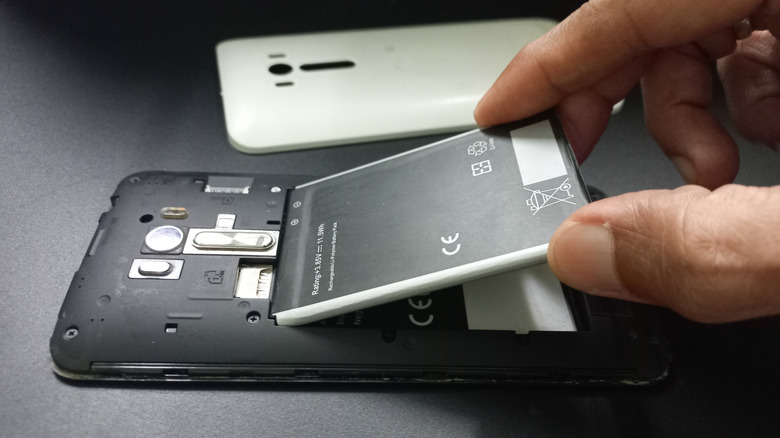Why Do Phone Batteries Not Last As Long In The Cold?
Have you ever noticed that your phone's battery doesn't seem to last as long out in the cold or during the winter months? You're not going crazy; batteries are affected by temperature, mostly due to cold weather. Why is that, exactly? It's the same principle as to why EV batteries drain faster in the winter. The chemical makeup of the battery inside your phone is largely to blame, as most phones contain lithium-ion batteries. Batteries contain electrolytes, usually as a fluid, and they work by transferring ions, or charged particles, between electrodes inside the battery. While charging, the ions, in this case lithium, move from a cathode to an anode, and move in the opposite direction while discharging — during use. This flow is what creates the electrical energy. In cold weather or lowered temperatures, the cold interferes with the movement of the ions.
Those ions slow down in the cold and that means they can't properly interact with the electrodes, coating the anode instead of transferring to the cathode, hampering the flow of electricity. The battery is unable to produce as much current before draining. But it's two-fold, because as you're using the device, draining the battery, which cannot produce as much of an electrical charge, it's working harder — and that is essentially making the battery drain faster.
What temperatures are bad for lithium-ion batteries?
Experts list the functional discharge temperature range for lithium batteries as between -4 degrees Fahrenheit and 140 degrees Fahrenheit. Anything outside of that range is less than optimal for "discharging" or using the device, with the ideal range resting between 66 degrees Fahrenheit and 77 degrees Fahrenheit. Meanwhile, ideal charging temperatures are slightly different, between 32 degrees Fahrenheit and 113 degrees Fahrenheit. Anything outside that range is less than optimal when charging the battery. In addition, charging a battery in temperatures lower than 32 degrees Fahrenheit can cause damage, so even though these are the ideal listed ranges, it's not necessarily what you should be exposing your phone and battery to.
AI may have found new materials to replace lithium inside modern batteries, but even if that does pan out, it will be a while before alternatives are commercially available. As a result, it makes sense to consider some better ways to care for them, or at least preserve them when you're venturing out into the cold.
One of the best ways to keep your device batteries safe is to keep them warm, obviously. But if you're going to be outside in the cold, keep them inside a jacket or warm pocket — even your pants pockets. Alternatively, you might consider using a winter-ready pocket or hand warmer. You don't want it scorching hot, mind you, just enough to keep it warm inside your apparel. You might also activate the battery saving mode on your phone to conserve charge, or just shut it down when you're not using it. Moreover, for some extra battery power when you need it, you can carry a portable power pack.

